Published online at Louisville, Kentucky USA -
An independent, secular, contemporary journal of political and environmental issues dedicated to peaceful reduction of human impacts on Earth
Published online at Louisville, Kentucky USA -
An independent, secular, contemporary journal of political and environmental issues dedicated to peaceful reduction of human impacts on Earth


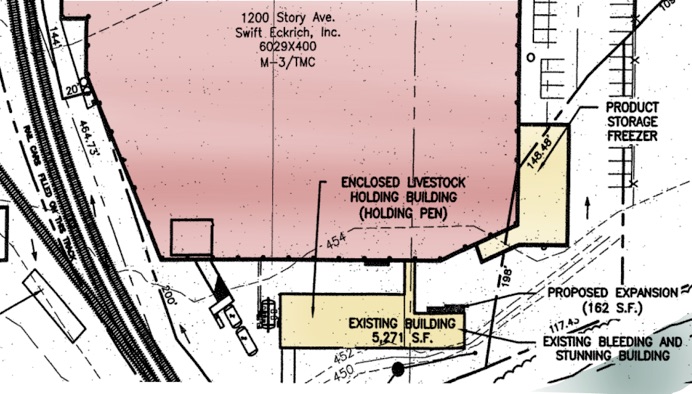


Stalking the abattoir
JBS Swift plant in Butchertown besieged by unhappy neighbors
(c) 2015 Bud Hixson


My boots crunched through crusted ice as I forged along East Main Street next to the JBS Swift slaughterhouse. Just a long block ahead the dark green waters of Beargrass Creek emerged from the concrete channel of the ‘improved’ South Fork, merged with the Middle Fork and formed the ‘final mile’ that runs past the flood pumping station through the greenway woods to the Ohio River. Where East Main crosses the creek on a bridge, a rail siding leads into the JBS Swift property.
The slaughterhouse receives delivery of live hogs from livestock trucks and kills as many as 10,500 animals per day according to statistics from its conditional use permit application. Walking along the holding pens I heard an occasional squeal as the pigs milled about in the confinement shed or were directed up the chute towards the stunning and bleeding room. I have walked this path many times over the last 20 years and the smells and noise have been much worse in the past. Today a strong whiff of pig manure wafted into the street, but the cold wind cleared the air as I neared the reconstructed bridge.
Behind the long white pig sheds, the red brick of the buildings rise up several stories topped with air pollution control and cooling equipment. The Butchertown Neighbors have been engaged in civil litigation since 2006 against the slaughterhouse, trying to contain its expansion and get it to shut down and move to a more rural location. To defend against the neighbor complaints, Swift has installed more aggressive odor control, built roofed sheds around animal handling areas and paid fines to the Air Pollution Control District. A part of the zoning action was an agreed investment in landscape plantings.
The civil litigation entered a new phase when Judge McKay Chauvin recently denied JBS Motion for Summary Judgment after a protracted exchange of memoranda challenging the neighbors ‘standing’ to bring the Complaint and some more obtuse procedural claims under the zoning code.
I am now a vegan. I had a heart attack last summer and had cardiac catheterization to clear a major heart artery. This fantastic and life-saving procedure happened at Norton Audubon. I can’t say enough good things. But part of being a vegetarian or vegan includes having questions about industrial meat production. As I walked alongside the plant and heard the squeals of the pigs, I couldn’t help but identify. Life is really a confined path where people in power shock you into forward motion, you lose contact with your family, and one day you see the end of the chute where your life’s blood will be drained.
Then I recall the delight I used to have to eat a ham sandwich dressed with cheese and lettuce and smothered with mayonaise on wheat bread. Cut diagonally and served with ruffle chips in the middle. I have dropped a lot of cash in delicatessens from Lexington to Philadelphia. In 1973, I was a livestock worker on a large Angus beef farm in central Kentucky. I had to scoop or use an electric auger to deliver silage in winter to a feed wagon towed behind a FORD tractor. I drove from the silo to the head of the long feed trough, then unloaded the feed into the trough. This was in winter with ice on the gravel road and I fought the tractor to keep the wagon from jack-knifing into the ditch. In the spring the young calves would be sold and loaded on trucks to go to fattening lots. For days the momma cows lowed around the barn, refusing to go to pasture, hoping their calves would somehow return. There is no doubt we produced anguish in those animals.
In 1994 or so, about the time the Cornerstone 2020 farce was cast into tablets, I searched for the next meaningful step, and joined EarthSave. The group was based on the understanding that the dietary choices of millions of people are having catastrophic impacts on the planet. The use of major percentages of the annual harvest of cereals and grains to produce a pound of animal flesh leads to unsustainable pollution of air land and water. The first world seduction into diets heavy with red meat increases income disparity and contributes to global warming. The USDA Diet Advisory Committee agrees.
In a Report released in February 2015, the USDA Dietary Advisory Committee, 20 years after EarthSave’s organizing, cautioned that it was true--what we put on our plates has global implications. Diets heavy in meat have major environmental and public health implications:
“About half of all American adults- II7 million individuals-have one or more preventable chronic diseases that relate to poor quality dietary patterns and physical inactivity, including cardiovascular diseases, hypertension, type 2 diabetes, and diet-related cancers. More than two-thirds of adults and nearly one-third of children and youth are overweight or obese. These devastating health problems have persisted for decades, strained U.S. health care costs, and focused the attention of our health care system on disease treatment rather than prevention.”
“The major findings regarding sustainable diets were that a diet higher in plant-based foods, such
as vegetables, fruits, whole grains, legumes, nuts, and seeds, and lower in calories and animal based foods is more health promoting and is associated with less environmental impact than is the current U.S. diet.”
2015 Dietary Guidelines Advisory Committee (DGAC) U.S. Department of Health and Human Services (HHS) and the U.S.Department of Agriculture (USDA).
“The DGAC concurs . . .that strong and consistent evidence demonstrates that dietary patterns associated with decreased risk of CardioVascular Disease are characterized by higher consumption of vegetables, fruits, whole grains, low-fat dairy, and seafood, and lower consumption of red and processed meat, and lower intakes of refined grains, and sugar-sweetened foods and beverages relative to less healthy patterns.” Part D. Chapter 2:
Diet related colon and bladder cancers have been explored in regards to carcinogens--such as benzo(a)pyrene-- that form when oily flesh is seared in stove top skillets, cooked in smokers or turned over flame brasiers. Rib lovers take heed.
“BaP mainly accumulated in the smoked casing, being four times in excess of the legal limit. This paper analyses the mechanism for preventing PAHs contamination during the process of smoking meat products.”
Benzo(a)pyrene penetration on a smoked meat product during smoking time.
The highest levels of BaP (up to about 4 ng BaP/g of cooked meat) were found in grilled/barbecued very well done steaks and hamburgers and in grilled/barbecued well done chicken with skin. BaP concentrations were lower in meats that were grilled/barbecued to medium done and in all broiled or pan-fried meat samples regardless of doneness level.
Even this year, 2015, I have smelled the JBS Swift plant from the front steps of my apartment in the original Highlands many blocks away. Nuisance odors are one of the chief complaints. The long transport trucks and the idling refrigeration trucks, their movements to and from the plant, and their rows parked and amounting to off-plant meat storage, are other contentious issues for neighbors.
Inside the plant, the actual process of killing and bleeding is subject to federal regulation and monitoring to assure ‘humane slaughtering’ and sanitary conditions for handling of the various products harvested. "The operation of killing hogs and eviscerating carcasses, [ ] is conducted under the observation of the USDA Federal Safety Inspection Service". FSIS regulations can include remote video monitoring and recording of the killing floor action and immediate interruption if necessary by federal inspectors to assure humane killing procedure. Animals are supposed to be shocked with electric current into instant insensibility and then bled to death before they can regain awareness.
Business has been good for the pork products producer as the JBS webpage proclaims:
http://www.jbssa.com/Brands/Pork/
Largest Animal Protein Company In The World.
“Employing more than 85,000 people in North America and Australia, JBS USA is a leading animal protein producer and exporter with a leading position as a beef and lamb producer in the U.S. and Australia. We are also a relevant producer of pork in the U.S. and a leading chicken producer in the U.S., Mexico and Puerto Rico.”
“Worldwide we are the largest animal protein processor in the world with 140 production facilities. Our global, diversified, low-cost production platform is the foundation for a variety of our products including food, leather, pet products and biodiesel. An international industry leader, JBS USA is owned by JBS SA, a Brazilian multinational.”
Air Emissions and Odor Control Systems
At our Louisville, Kentucky pork processing plant, we installed new 40,000 cubic foot per minute (CFM) pack bed scrubbers to address “high intensity” processes and improve general room air. We then upgraded to a 75,000 CFM room air scrubber. We installed a softener for the scrubbers to minimize scaling and required water usage. We covered the grease tank to minimize vapor to room air. We installed two new shell and tube condensers to more efficiently recover waste energy. Louisville creates over 300,000 gallons per day of 140 degree water from waste heat. This hot water is then used to effectively clean the plant. By utilizing this waste heat we reduce our usage of natural resources (i.e., natural gas) and our carbon footprint.
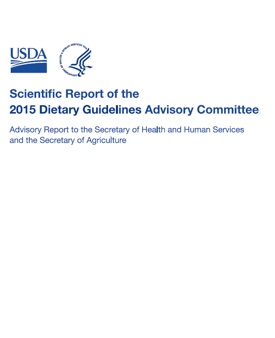
“The global production of food is responsible for 80 percent of deforestation, more than 70 percent of fresh water use, and up to 30 percent of human-generated greenhouse gas (GHG) emissions. It also is the largest cause of species biodiversity loss.”
Part D. Chapter 5: Food Sustainability and Safety Scientific Report of the 2015 Dietary Guidelines Advisory Committee
2015 Dietary Guidelines Advisory Committee
2. Slaughtering shall be defined as: "The operation of killing hogs and eviscerating carcasses, all of which is conducted under the observation of the USDA Federal Safety Inspection Service". CUP permit
Aug. 7, 1997
U.S. could feed 800 million people with grain that livestock eat, Cornell ecologist advises animal scientists
"If all the grain currently fed to livestock in the United States were consumed directly by people, the number of people who could be fed would be nearly 800 million," David Pimentel, professor of ecology in Cornell University's College of Agriculture and Life Sciences, reported at the July 24-26 meeting of the Canadian Society of Animal Science in Montreal. Or, if those grains were exported, it would boost the U.S. trade balance by $80 billion a year, Pimentel estimated.
More than half the U.S. grain and nearly 40 percent of world grain is being fed to livestock rather than being consumed directly by humans,"
The 7 billion livestock animals in the United States consume five times as much grain as is consumed directly by the entire American population.
Each year an estimated 41 million tons of plant protein is fed to U.S. livestock to produce an estimated 7 million tons of animal protein for human consumption.”
http://www.economist.com/blogs/feastandfamine/2013/12/livestock
“But a reduction in the size of the business isn’t going to happen soon, if ever. Urbanization and rising incomes mean that more of the world is converging on European and American levels of meat consumption, which is roughly 100kg a year (80kg in Britain, 120kg in America). At the moment, most of Africa and South Asia eats less than 20kg of meat a year. Even if parts of India remain vegetarian, shifting patterns of demand imply worldwide meat consumption will double by 2050.”
The Economist Meat and greens
Dec 31st 2013, 18:28 by J.L.P.
As I skulk along the outer boundaries of the abattoir, I imagine a burly contingent of the 1,200 workers dispatched to run out and gather me up as if I were an animal that had strayed, lifted up the gate with my snout and fled. I despair at the brutality of humans, indifferent to millions of animals being raised in confined and wretched conditions, merely to provide a meat option at the table. Our ancient lust for the hunt and physical need for carnality--to be bathed in blood and stand triumphant over the kill-- runs through us-- like the ‘Jungle Line’ of Joni Mitchell song.
Earlier, I crunched along the floodwall past the James Starkey Sewage pumping facility. JBS Swift is a ‘significant industrial user’ (SIU) of the Louisville Combined Sewer. A main problem with sewers that overflow in wet weather is that unless the discharges are stopped at the plant, effluent from industrial dischargers also overflows to the creek and river. Before the Clean Water Act and earlier in the 20th Century the offal dumped into Beargrass Creek from Butchertown was so noxious that city government diverted the creek in a long straight channel to the Ohio River to its present outlet upstream of the Waterfront Park and Big Four Bridge. In the 1970s and 1980s MSD issued permits to SIUs that permitted continued discharges with no requirement to halt flows in wet weather. In recent years, more attention is paid to industrial effluents in wet weather overflows--but they still occur. They used to occur a lot more from the James Starkey pump station but capacity upgrades have netted reductions.
At the corner of Cable Street and the Floodwall I zipped my jacket tighter and looked into the former staging facility for MSD that has been sold now to JBS Swift. The sale provoked the most recent controversy. It seemed to have been cooked up in the back room at MSD and served steaming hot as a finished course without prior consultation with the neighbors. Thus, a strategic site for expanded production passed into the ownership and control of JBS. This was not to the liking of the neighbors who filed affidavits complaining about semi-trucks idling and moving through the neighborhood along Adams Street and Story Avenue and parked in rows with refrigeration units roaring through the night. The Cabel Street lot backs up across a field to the interstate I-71 and I-264 roadways that run along the Ohio River. Truck and automobile traffic is incessant, flows that move the nations commercial output as the human population bulges on this tiny planet.
The floodwall is patched with paint covering over the graphic howls of marginalized people impossibly reduced to the status of urban livestock. Herded through bewildering elementary schools, shopping in vast consumer boxes, being fattened for the kill of mass incarceration, morbid obesity or consumer debt slavery. I am stunned by the garish gloss over a life brilliant in color and sound, euphoric and staggering in cosmic scope, but often utterly lacking in basic human decency for many. In the background a rhythmic pneumatic clunk sounds as another pig walks into the light.
Transport trucks now have to be decontaminated in truck washes
Zoning battle focused on the expansion of the bleeding and stunning shed
Driving up Cabel Street a meat products semi-truck
Cabel Street Lot
PLoS One. 2013;8(3):e58591. doi: 10.1371/journal.pone.0058591. Epub 2013 Mar 6.
Combined genotoxic effects of a polycyclic aromatic hydrocarbon (B(a)P) and an heterocyclic amine (PhIP) in relation to colorectal carcinogenesis.
Colorectal neoplasia is the third most common cancer worldwide. Environmental factors such as diet are known to be involved in the etiology of this cancer. Several epidemiological studies have suggested that specific neo-formed mutagenic compounds related to meat consumption are an underlying factor involved in the association between diet and colorectal cancer. Heterocyclic amines (HCAs) and polycyclic aromatic hydrocarbons (PAHs) are known mutagens and possible human carcinogens formed at the same time in meat during cooking processes. Because of their genotoxic effects observed on heterozygous Apc mutated cells and their possible combined genotoxic effects, both B(a)P and PhIP, taken together, could be implicated in the observed association between meat consumption and colorectal cancer.
Food Chem Toxicol. 2015 Jan 26;78C:1-9. doi: 10.1016/j.fct.2014.12.018. [Epub ahead of print]
Investigation into the formation of PAHs in foods prepared in the home to determine the effects of frying, grilling, barbecuing, toasting and roasting.
The effects of frying, grilling, barbecuing, toasting and roasting on the formation of 27 different PAHs in foods were investigated. Barbecuing with charcoal plus wood chips however resulted in the formation of benzo[a]pyrene in most foods; for beef burgers only, barbecuing over charcoal (without the use of wood chips) gave the highest levels. In general PAH levels increased when the food was barbequed closer to the heat source.
For sausages cooked over briquettes, and for beef burgers, beef and salmon cooked over charcoal, the concentration of PAHs was lower when the food was closer to the heat source. Cooking time may result in a moderate increase of PAHs in some foods, although concentrations in beef burgers appeared to fall when cooking time was extended by 50-100%.
Cancer Res. 1999 Sep 1;59(17):4320-4.
Well-done, grilled red meat increases the risk of colorectal adenomas.
Red meat or meat-cooking methods such as frying and doneness level have been associated with an increased risk of colorectal and other cancers.
There was an increased risk of 11% per 10 g/day (or 2.5 oz/week) of reported red meat consumption (OR, 1.11; CI, 1.03-1.19).
Maturitas. 2015 Mar;80(3):258-264. doi: 10.1016/j.maturitas.2014.12.017. Epub 2015 Jan 9.
Diet and colorectal cancer.
Obesity increases the risk of CRC by 19%. Regular physical activity reduces this risk by 24%.
CRC risk derived from red meat intake is influenced by both total intake and its frequency.
BadwaterJournal.com
WHAT UNSUSTAINABLE URBAN GROWTH LOOKS LIKE
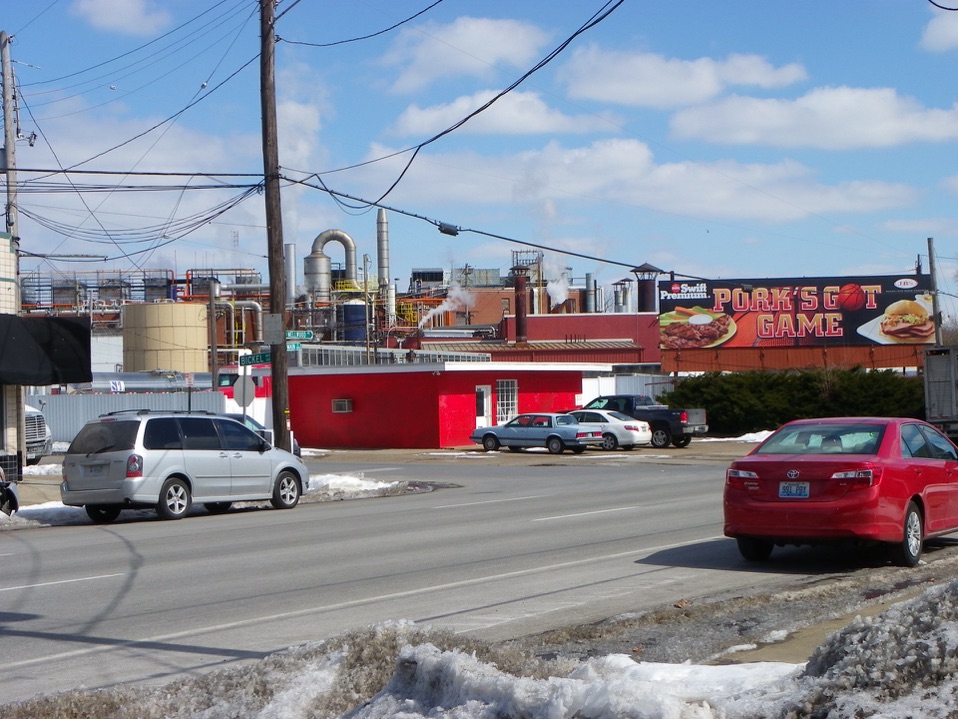
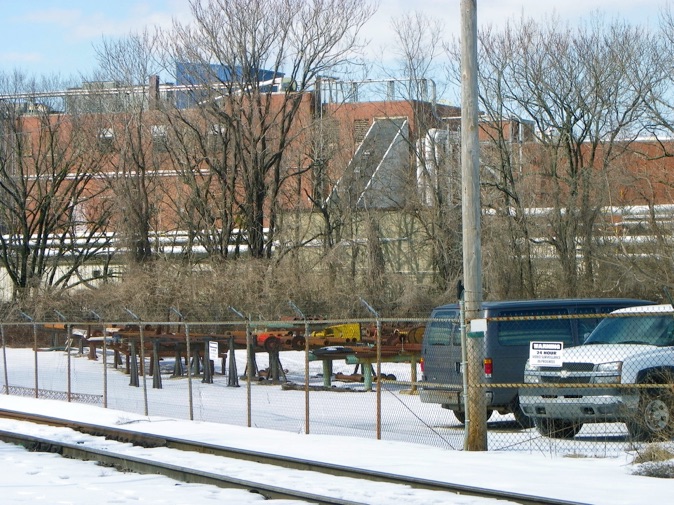


Supplying the abattoir
Confined animal feeding operations in Kentucky are too cruel and have porcine virus epidemic
(c) 2015 Bud Hixson
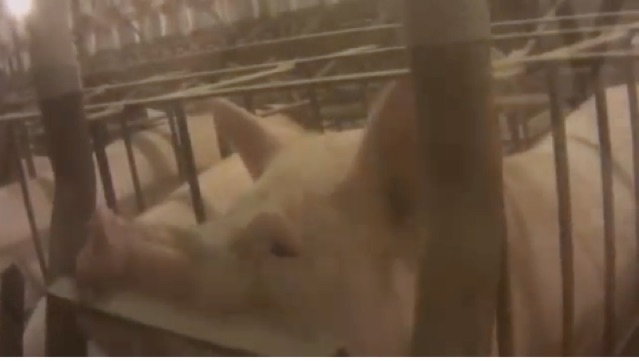
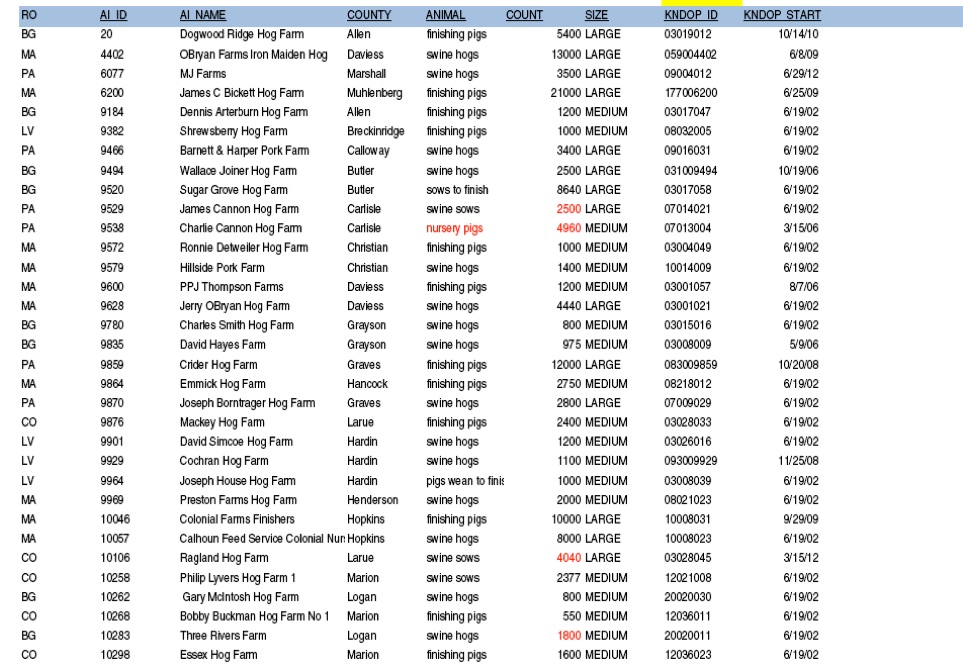
KENTUCKY’s LARGEST HOG FARMS Source: KY Division of Water- March 2015

5,400
13,000
21,000
8,640
12,000
10,000
8,000
10,500
5,000
8,000
4,960
5,000
5,000
5,000
4,960
4,960
4,960
4,960
7,470
4,960
4,960
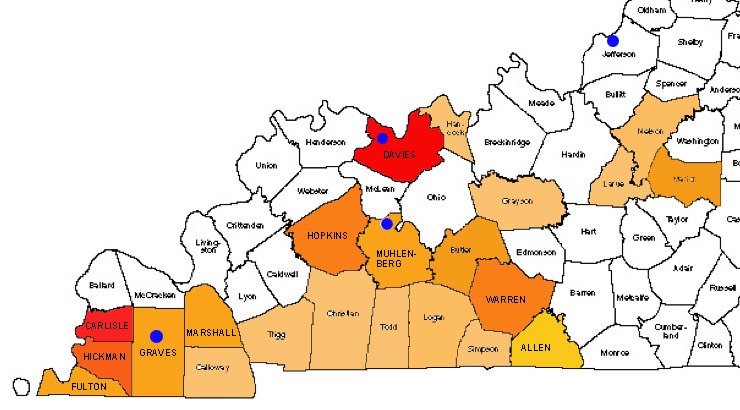
LARGEST CAFO HOG COUNT BY COUNTY
1 DAVIES COUNTY 38,110
2 CARLISLE 32,076
3 HICKMAN 29,760
4 FULTON 24,720
5 WARREN 24,178
6 MUHLENBERG 21,000
7 MARSHALL 20,080
8 HOPKINS 18,000
9 GRAVES 14,800
10 ALLEN 14,050
JB SWIFT SLAUGHTERHOUSE
LOUISVILLE
SECOND LARGEST CAFO
13,000 IRON MAIDEN
DAVIES COUNTY
LARGEST CAFO
21,000 JAMES BICKETT
MUHLENBERG COUNTY
THIRD LARGEST CAFO
12,000 CRIDER HOG FARM
GRAVES COUNTY
See Humane Society video HERE


The attractive appearance of meat products gives no information to consumers about the way animals are fed and confined. There is a disconnect between the inhumane industrial production methods and upbeat packaging meant to trigger purchases. The consumer should demand packaging be labeled to disclose if its a CAFO product and what type of feed was used.
The aim of confinement production methods is to maximize the efficiency of producing a pound of meat. Every method of cost saving is explored. For example, the PEDv corona virus is now confirmed to have spread throughout the CAFO network through supplies of feed pellets. The feed pellets were made using blood and plasma from the hog slaughterhouses shipped in trucks to the pellet manufacturer. Co-mingling the blood and plasma of millions of pigs introduced the virus and mutations into the pellets that were then shipped to CAFOs and fed across the United States. Feeding abattoir hog tissue back to growing hogs has opened the door to viral infections.
In Kentucky, hogs are fed distillers grains, a left over product of whiskey brewing. That is sometimes blended with ‘beef tallow from beef slaughterhouses along with other ingredients. “Distillers dried grains with solubles (DDGS) can be included in diets fed to growing pigs in all phases of production, beginning at 2 to 3 wk postweaning, in concentrations of up to 30% DDGS, and lactating and gestating sows can be fed diets containing up to 30 and 50%, respectively, without negatively affecting pig performance.
J Anim Sci. 2009 Apr;87(4):1292-303. Board-invited review: the use and application of distillers dried grains with solubles in swine diets. Stein HH1, Shurson GC
“Hence, total costs are difficult to estimate too. Burkgren says, "The amount of piglets that have perished can be multiplied with $75, the average price of a weaned pig. And that is just the pig losses. I'm not sure where we stand if we also add production and reproduction losses or the cost of cleaning, disinfecting and increased biosecurity."
http://www.pigprogress.net/Health-Diseases/Health/2015/1/How-to-stop-PEDv-1580659W/
The last year has been manic, and the challenge of PEDv has proven to be a tough one, Burkgren notes. He has been attached to the AASV since 1994 and has as such been involved with e.g. the eradication of pseudorabies (Aujeszky's Disease) in the US pig industry. It's tempting to compare the outbreaks of PEDv with that of earlier viruses to those of Porcine Circovirus 2 (PCV2) and PRRSv (Porcine Reproductive and Respiratory Syndrome). Burkgren says, "In a way, we can see some of the same effects. The death losses and farms affected – and very severe clinical signs. All three diseases have shown very high mortality especially for the younger piglets."
"The virus destroys the villi of the intestines and it is very similar to Transmissible Gastro-Enteritis (TGE). In a way it is quite shocking to see what damage it can do to baby pigs."
The virus appears to have mutated as well, as in January 2014, researchers at the Animal Disease Diagnostic Lab of the Ohio Department of Agriculture distinguished a second variety which was later confirmed by Iowa State University and the University of Minnesota, Burkgren says. In this variety sows were known to be infected, and although piglets also did show clinical signs and died, it was in some cases not as severe as the original strain.
To make things a little more complicated, another coronavirus also first appeared in the US in February of this year. Clinical signs of this virus, called Swine Delta Coronavirus (SDCv), has been reported to be similar to PEDv, causing diarrhoea and vomiting and all age groups and mortality in nursing pigs. Mortality rates, however, appear lower than in cases of PEDv. Both diseases (PED and SDCv) are reportable in the US and Canada.”
“Kentucky hog producers’ whose herds have been infected with PEDv have estimated total production losses to be as high as 20 percent for 2014 based on the number of litters lost. Even with increased profit margins, financial consequences are severe for those whose herds get infected. Mortality rate for piglets born after contracting the virus on the farm is nearly 100 percent. Sows and older pigs contract the disease but usually recover. When PEDv strikes, the on-farm production cycle is depressed, and it takes a few months to return to full production. Potentially more troublesome, anecdotal evidence exists that attempts to immunize the herd through exposure may have a limited effect. Some farms have experienced more than one PEDv outbreak already.”
Excerpts from articles
When a pig climbs the chute at the abattoir to be slaughtered the USDA insists that the death be quick and certain beginning with an electric shock that stuns the animal unconscious followed by slashing the carotid artery to drain the body before the animal can regain consciousness. Whats not part of that narrative is the cruelty industrial hog production inflicts on these meat animals prior to the final moment. As a result of the confinement model of operation, mother pigs are kept in steel crates where the litters of piglets nurse on sows that are lame from lack of movement and lying in their excrement. Profit motive drives the design, but recent epidemic disease is causing significant losses of piglets. Between 2013 and the present it is estimated more than 8 million piglets and swine have been lost to Porcine Epidemic Diahrea Virus or PEDv. This corona virus has infected confined operations across the U.S. and spreads through fecal-oral contact.
In response to Kentucky Open Records request to the Kentucky Division of Water, BadwaterJournal received the lists of the 168 hog operations in the state that have received Kentucky No Discharge Operating Permits. In a sellout of the environment to the industrial animal operators, the state legislature approved rules that pretend large animal operations don’t discharge waste water to surface and groundwater. Under no-discharge rules there is no regulated point discharge outlet to a river as with a Clean Water Act pollution permit. There are no requirements for effluent testing since presumably there is no effluent. Instead fecal waste and washdown water are accumulated in large storage ponds or in concrete bunkers under the confinement building then sprayed across adjacent fields. The larger CAFOs are required to provide a comprehensive nutrient management plan CNMP that estimates pounds per acre phosphorus and nitrogen applied. Many runoff events to local waters have been reported.
Center for Disease Control tracking porcine epidemic and other confined animal viral diseases
(c) 2015 Bud Hixson
The industrial production of meat products for the global consumer market has resulted in concentration camps of pigs, beef, turkeys, chicken and other animals. The animals are kept in unnatural confinement where fecal waste builds up and is then washed down with power sprayers into a pit or lagoon. Disease pathogens are mutating and adapting in the CAFOs and now killing millions of animals per year. The Center for Disease Control has not focused on phasing out inhumane CAFOs, instead the CDC tracks the mutations of new viruses intending to alert the general public when a virus jumps the species barrier and becomes infectious in humans. CAFOs are a reservoir for future human pathogens.
The U.S. hog and turkey CAFO operations are now seeing epidemic infections of confined animals. Human workers that have been in contact with CAFO turkeys infected with avian flu virus are being monitored in Minnesota. Outbreaks of avian flu have killed thousands of turkeys in Arkansas, Minnesota, and Ontario. The loss of millions of animals due to infectious viral epidemics may do what pleas to humane treatment have not--the loss of profits may deter capitalists from building large confinement facilities.
This is from an April 2015 CDC report:
Pathogenicity of 2 Porcine Deltacoronavirus
Strains in Gnotobiotic Pigs
“Porcine epidemic diarrhea virus (PEDV) (family Coronaviridae, genus Alphacoronavirus) was discovered in the United States in May 2013. The virus has now spread nationwide and caused a high number of deaths among suckling pigs. In regions of the United States to which PEDV is epidemic, a new coronavirus, genetically distinct from PEDV, porcine deltacoronavirus (PDCoV) (genus
Deltacoronavirus), has been simultaneously and frequently detected in diarrheic fecal samples from pigs .
Emerging Infectious Diseases • www.cdc.gov/eid • Vol. 21, No. 4, April 2015
“In December 2014, the United States Department of Agriculture (USDA) confirmed the presence of highly pathogenic avian influenza (HPAI) H5 viruses in both domestic and wild birds in the United States. No human infections with these viruses have been detected in the United States, Canada or internationally at this time, however, similar viruses have infected people. It’s possible that human infections with these viruses may occur. While human infections are possible, infection with avian influenza viruses in general are rare and – when they occur – these viruses have not spread easily to other people. CDC considers the risk to people from these HPAI H5 infections in U.S. birds and poultry to be low at this time, but has developed interim guidance on testing and prophylaxis. More information about detections of HPAI in U.S. birds is available through a link on the USDA website
http://nieman.harvard.edu/wp-content/uploads/pod-assets/microsites/NiemanGuideToCoveringPandemicFlu/TheScience/CrossingTheSpeciesBarrier.aspx.html
Crossing the bridge
“Many infectious diseases cross the species barrier. In most cases, humans come into contact with the animal itself, animal excreta, or animal parts (e.g., feathers, meat), or an insect is the vector of transmission of the infective microorganism. Classic examples of these forms of disease transmission are Lyme disease, plague, and the rabies virus.2
Animal influenza viruses do not infect humans on a regular basis, and all influenza viruses usually show some receptor specificity for their hosts, be they birds or mammals.
Areas where birds, pigs, and humans live close together do, however, provide major opportunities for influenza viruses to step across the species barrier and infect other animals or humans. Once the bridge is crossed, the stage for the creation of new influenza viruses is set.”
Influenza viruses can change by reassortment and by accumulating mutations (antigenic drift). The segmented nature of the influenza genome permits a circulating seasonal human influenza to acquire new genes through reassortment (antigenic shift). Such events can occur when an individual is co-infected with a seasonal virus as well as an avian virus or a virus adapted to a mammalian host, such as swine.
Interactions between humans and infected animals also may allow for viral recombination or adaptation to a new organism by repeated infections with mutated viruses. Reassorted or mutated viruses can have genes or gene combinations that allow them to cross species barriers more easily and adapt to new hosts.3
Two Pieces of Bread and a Slice of Corruption
(c) 2015 Bud Hixson

"Coronaviruses (CoVs) are enveloped, single-stranded, positivesense RNA viruses in the family Coronaviridae that is within the order Nidovirales. The Coronaviridae contain at least four major genera: Alphacoronavirus, Betacoronavirus, Gammacoronavirus, and Deltacoronavirus.
Porcine CoVs are significant enteric and respiratory pathogens of swine.
In 1946, porcine transmissible gastroenteritis virus (TGEV), an alphacoronavirus (-CoV), was identified as the cause of a devastating enteric disease of pigs in the United States (1).
A second U.S. porcine -CoV, porcine respiratory coronavirus (PRCV), was officially identified in 1984 (2). PRCV is a deletion mutant of TGEV that alters viral tropism from intestinal to respiratory epithelia (3, 4).
In swine, PRCV replicates almost exclusively in the respiratory tract and closely resembles other porcine viral pneumonias (2–4). In 1971, a new -CoV, porcine epidemic diarrhea virus (PEDV), was identified in the United Kingdom (5).
Both TGEV and PEDV replicate in small-intestinal enterocytes, causing life threatening
acute enteric disease in suckling piglets that is characterized by profuse watery diarrhea, emesis, and resultant dehydration (1, 6, 7). Morbidity rates are high (80 to 100%), as are mortality rates (50 to 90%) (1, 8).
Since 2010, variant strains of PEDV differing in sequences from the classic European strain (CV777) have appeared in China, South Korea, Japan, and many Asian countries, causing up to 100% mortality in suckling piglets (8, 9).
In May 2013, PEDV was identified as a new cause of neonatal diarrhea in Iowa (10, 11). Infection rapidly spread to more than 30 states, Canada, and Mexico and caused significant economic losses in the swine industry (12–14). Sequence analyses suggest that U.S. PEDV strains originated from China (12)."
Origin, Evolution, and Virulence of Porcine Deltacoronaviruses in the United States
Yuanmei Ma, Yu Zhang, Xueya Liang, Fangfei Lou, Michael Oglesbee, Steven Krakowka, Jianrong Li March/mBio.asm.org April 2015 Volume 6 Issue 2 access through PubMed online
Under Kentucky’s industry friendly Kentucky No Discharge Permit program, the Division of Water is not requiring reporting of animal mortality disposal--- though they have that authority to protect ground and surface waters. Deep lagoon pits of manure harbor virus pathogens under the CAFO slat floors. City-sized CAFO torture chambers of doomed mammals were designed for maximum profit. CAFO operators searched out alternative cheaper feed sources—brewers solids from the bourbon industry and blood and plasma from the same slaughterhouses where pigs are killed-remixed with grain into feed pellets that included antibiotics. The industrialists tried to squeeze a dollar out of massive operations by ignoring nature and aesthetics and feeding blood and plasma products from the slaughterhouse. The crowded CAFOs pooled MRSA-Staphylococcus aureus bacteria rapidly transferring it to livestock workers and into the community.
Losing millions of piglets to disease, CAFO industrialists adopted aggressive biosecurity practices—requiring transport trucks to wash down and decontaminate, workers have donned moonsuits and limit access between CAFO buildings. Now studies show the pathogens are contaminating the air, land, water, wild animals and people living around CAFOs.
The CAFO industrial livestock model has proven a disaster for investors, a disaster for state water resources, and will likely prove an actual public health disaster when a newly mutated virus jumps the species barrier and causes a new human pandemic. It is a sublime irony that in trying to maximize profits by crowding animals into industrial assembly line procreation and Frankenstein science breeding, the super scientists instead, created the ideal breeding grounds for deadly infections. After more than 8 million piglets have died since 2013 to PEDV alone and as new infections of avian flu virus are causing states to kill millions of turkeys and chickens, a national conference to produce uniform CAFO regulations--or ban them- is critically needed.
The virus affecting North American Swine has mutated multiple times to become a major killer of confined animals. The Corona virus circulating in CAFO swine, migratory birds, CAFO poultry, bats, domestic pets and human beings will sooner or later, trip the genetic combination, and a new pandemic will sweep across the states. This zoonotic cross species transfer is facilitated by animal crowding in their own feces in cages in CAFOs. The first casualty in the war between profits and humane animal farming is truth about the spread and human health risk of CAFO PEDv and other zoonotic pathogens.
Mutations and variants of the corona virus infecting North American swine


In April, 2015, I filed Open Records requests in Kentucky to obtain information and statistics about the spread of Porcine Epidemic Diarrhea Virus (PEDv). This epidemic has killed millions of piglets nationwide. Kentucky has seen rapid expansion of industrial scale swine CAFOs in the western counties. The sparsely populated rural area is dominated by agriculture including livestock and chicken franchise contract growing operations serving the national appetite for meat sandwiches.
The area is now fielding a gubernatorial candidate, James Comer, conservative Republican, who is the present Commissioner of Agriculture. Here is the response to my Open Records Request from his Kentucky Dept of Agriculture:
Mr. Hixson:
In response to your record request detailed below, the Kentucky Department of Agriculture (KDA) responds as follows:
1) The KDA does not have public records for the years 2013, 2014, and 2015 in its custody that identifies by name KDA staff that track, chart, record the extent of, or otherwise study or investigate Porcine Epidemic Diarrhea virus and similar viral epidemics caused by other infectious agents in this state.
Individual Answering:
Nicole T. Liberto; on behalf of Kentucky State Veterinarian, Dr. Robert Stout.
2) The KDA does not have public records for the years 2013, 2014, and 2015 in its custody that identify by name KDA staff who formulate reports and summaries for the Governor or Secretary regarding Porcine Epidemic Diarrhea virus and similar viral epidemics caused by other infectious agents in this state.
Individual Answering:
Nicole T. Liberto; on behalf of Kentucky State Veterinarian, Dr. Robert Stout.
3) 1) The KDA does not have public records for the years 2013, 2014, and 2015 in its custody that are Summaries or Reports written for and presented to the Governor or Secretary describing the Porcine Epidemic Diarrhea virus infection and resulting mortalities In this state.
Individual Answering:
Nicole T. Liberto; on behalf of Kentucky State Veterinarian, Dr. Robert Stout.
The Open Records responses make you wonder how Agricultural Commissioner James Comer would do as a Governor of Kentucky
since he apparently has not received or demanded any in-depth report on the corona virus epidemic in the confined animal industry. Zoonotic virus pathogens that cross the species barrier flourish in CAFOs.
80 percent mortalities of a 1,000 sow operation producing litters of 8 piglets would be 6,400 dead piglets with each cycle.
6,400 dead piglets amounts to a disposal problem. Multiply that times large farms with 21,000, 13,000 or 12,000 head of animals
and we have a hidden statewide pig mortality disposal problem that is either being landfilled or stuffed in holes on farms.
Concentration of Swine Production in the U.S. - USDA
Impact of Porcine Epidemic Diarrhea on Performance of Growing Pigs. PLoS Alvarez J, Sarradell J, Morrison R, Perez A (2015)
ONE 10(3): e0120532. doi:10.1371/journal.pone.0120532
Antibiotic-Resistant Enterococci and Fecal Indicators in Surface Water and Groundwater Impacted by a Concentrated Swine Feeding Operation
Amy R. Sapkota, Frank C. Curriero, Kristen E. Gibson, and Kellogg J. Schwab, Vol. 115 No. 7 July 2007 • Environmental Health Perspectives
Infectious Diseases Associated with Livestock Production : Mitigating Future Risks vol. 121 number 8 August 2013
Environmental Health Perspectives
The Potential Role of Concentrated Animal Feeding Operations in Infectious Disease Epidemics and Antibiotic Resistance
Mary J. Gilchrist, Christina Greko, David B. Wallinga, George W. Beran, David G. Riley, and Peter S. Thorne
Environmental Health Perspectives • Vol. 115 No. 2 February 2007
Concentration of Airborne Staphylococcus aureus
(MRSA and MSSA), Total Bacteria, and Endotoxins in Pig Farms
FREDERIC G. MASCLAUX , OLGA SAKWINSKA ,
NICOLE CHARRIÈRE , EULALIA SEMAANI and ANNE OPPLIGER
Ann. Occup. Hyg., Vol. 57, No. 5, pp. 550–557, 2013
Longitudinal Study of the Contamination of Air and of Soil Surfaces in the Vicinity of Pig Barns by Livestock-Associated Methicillin- Resistant Staphylococcus aureus
Jochen Schulz, Anika Friese, Sylvia Klees, Bernd A. Tenhagen, Alexandra Fetsch, Uwe Rösler, and Jörg Hartunga
aem.asm.org Applied and Environmental Microbiology p. 5666–5671 August 2012 Volume 78 Number 16
State-level transport flows are predictive of the dynamics of
porcine epidemic diarrhea virus
Eamon B. O'Dea, Harry Snelson, Shweta Bansal
Epidemiology, geographical distribution, and economic
consequences of swine zoonoses: a narrative review
Salah Uddin Khan Kalina R Atanasova , Whitney S Krueger, Alejandro Ramirez and Gregory C Gray
Emerging Microbes and Infections (2013) 2, e92; doi:10.1038/emi.2013.87
A novel coronavirus capable of lethal human
infections: an emerging picture
Gulfaraz Khan Virology Journal 2013, 10:66
http://www.virologyj.com/content/
Ebola Reston Virus Infection of Pigs: Clinical
Significance and Transmission Potential
Glenn A. Marsh, Jessica Haining, Rachel Robinson, Adam Foord, Manabu Yamada, Jennifer A. Barr, Jean Payne
The Journal of Infectious Diseases 2011;204:S804–S809
Evidence Supporting a Zoonotic Origin of Human Coronavirus Strain NL63
Jeremy Huynh, Shimena Li, Boyd Yount, Alexander Smith, Leslie Sturges, John C. Olsen, Juliet Nagel, Joshua B. Johnson,
Sudhakar Agnihothram, J. Edward Gates, Matthew B. Frieman, Ralph S. Baric, and Eric F. Donaldson Journal of Virology p. 12816–12825 December 2012 Volume 86 Number 23
Recombination, Reservoirs, and the Modular Spike: Mechanisms of Coronavirus Cross-Species Transmission
Rachel L. Graham and Ralph S. Baric
JOURNAL OF VIROLOGY, Apr. 2010, p. 3134–3146
Origin, Evolution, and Virulence of Porcine Deltacoronaviruses in the United States
Yuanmei Ma, Yu Zhang, Xueya Liang, Fangfei Lou, Michael Oglesbee, Steven Krakowka, Jianrong Li
March/April 2015 Volume 6 Issue 2 e00064-15
USDA Web site at www.aphis.usda.gov/animal-health/secd
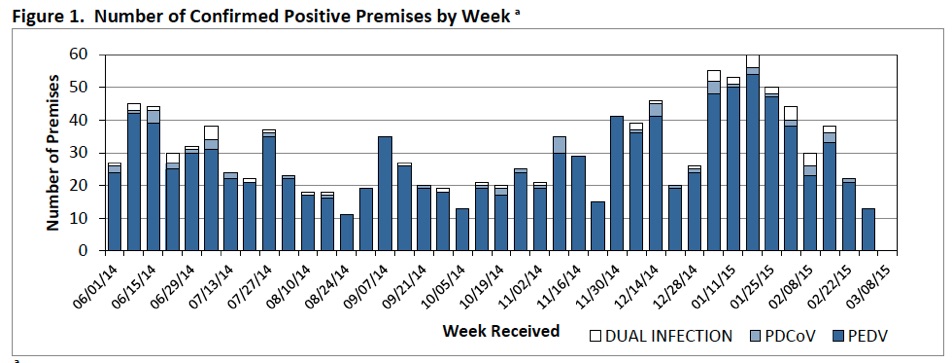
“Staphylococcus aureus can colonize pigs and can be emitted via ventilation systems into the ambient air of swine herd confined- animal feeding operations (12). The results of our longitudinal study demonstrate that MRSA can be isolated from ambient air and also from soil surfaces in the vicinity of pig farms. To the best of our knowledge, we show for the first time
a simultaneous detection of the same spa types within and outside pig farm operations. air treatment systems should be investigated for their ability to reduce emission of MRSA from animal houses.”
“In this study we investigated surface water and groundwater located up gradient and down gradient of a swine CAFO for the presence of fecal indicators.
Findings indicate that surface waters and
groundwater located down gradient of the
swine CAFO are contaminated with significantly higher levels of Enterococcus spp., E. coli, and fecal coliforms compared with surface water and groundwater located up gradient of the swine CAFO.”
Antibiotic-Resistant Enterococci
Epidemiology, geographical distribution, and economic consequences of swine zoonoses: a narrative review
Salah Uddin Khan , Kalina R Atanasova Whitney S Krueger , Alejandro Ramirez and Gregory C Gray
Emerging Microbes and Infections (2013)
“Although pigs are one of the major sources of animal protein globally, and the industry represents a large portion of the economy for
many countries, steps should be taken to minimize swine-associated zoonoses of public health concern.”




“An estimated 1 million pigs are transported daily. Pathogens are commonly spread through oral/fecal or nasal droplet contact, making transportation a common route of contamination to pig populations and facilities if not properly managed. Swine enteric corona viruses, including porcine epidemic diarrhea virus (PEDV) and porcine delta corona virus (PDCoV) are the most recent viruses of concern that are transferred via fecal and oral contact. . . . Producers frequently do not wash transporters that remove animals to harvest from an all-out site. Recognizing that a primary route of contamination is through contaminated transport, washing, disinfecting and drying transport trailers is an obvious process to reduce biocontamination.
Even though the value of washing, disinfecting and drying of transport has long been recognized, the industry has a tremendous shortage of facilities and/or inadequate truck washes and drying facilities”
“There is inherent contamination risk because trailers are contaminated with feces and bedding.
Environments within the washes are also conducive to pathogen survival and cross-contamination . . . PEDV requires a higher temperature and longer duration time for inactivation (160 degrees F for 10 minutes)
compared to 150 degrees F for five minutes
for porcine reproductive and respiratory
syndrome virus (Nitikanchana S„ 2014). To turn transporters around more rapidly, a high temperature automated system is necessary.”
November 15, 2014 www.nationalhogfarmer.com
Below: Swine truck wash on East Main Street across from JBS Swift. A truck is being power-sprayed with the aerosol open to the back exit.
“Staphylococcus aureus can colonize pigs and can be emitted via ventilation systems into the ambient air of swine herd confined- animal feeding operations . The results of our longitudinal study demonstrate that MRSA can be isolated from ambient air and also from soil surfaces in the vicinity of pig farms . . . Therefore, there is an urgent need for further studies in order to understand the survival of LA-MRSA in the outdoor environment and the transmission pathways. This may also help to better estimate the risks involved in the environmental LA-MRSA contamination of the vicinity of positive animal houses with regard to neighboring piggeries as well as to residential dwellings. Additionally, air treatment systems should be investigated for their ability to reduce emission of MRSA from animal houses.” aem.asm.org August 2012 Volume 78 Number 16 Longitudinal Study of the Contamination of Air and of Soil Surfaces in the Vicinity of Pig Barns by Livestock-Associated Methicillin- Resistant Staphylococcus aureus
Swine truck at Wenzel and Market Street in Louisville. Trucks cycle through urban Louisville main thoroughfares from interstate highways more than twice an hour.
Children at Lincoln Elementary


MSD Starkey Sewage pumping station on Buchanan Street
JBS Swift front office on Story Ave.


JBS Swift rail siding from Story Ave.
Looking north at JBSSwift in Butchertown from East Main Street. Beargrass Creek at the tree line